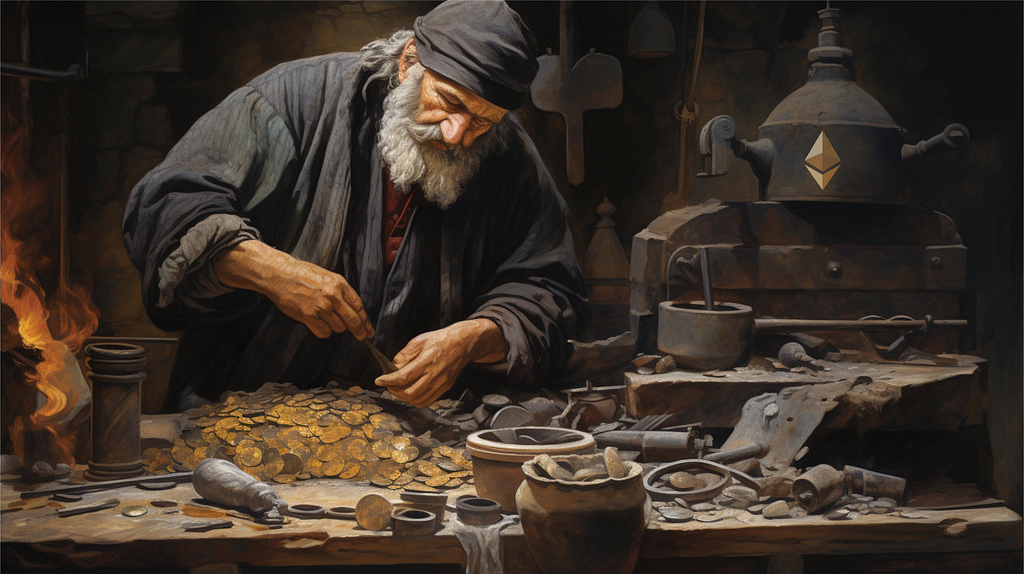Blog
 Mon, 13 Nov 2023 22:36:45 GMT by Silver / Toolblox
Mon, 13 Nov 2023 22:36:45 GMT by Silver / Toolblox
In a decade from now, all assets moving between businesses will be tokenized and transacted on the blockchain.
Tokenization is a method that involves keeping track of an asset in a central ledger, primarily benefiting from a substantial reduction in administration and transaction times.
The general idea of asset tokenization today is to create — or mint — a digital representation of an asset on the blockchain. This token can then be used to manage the asset through blockchain-native program called smart-contract: assign metadata to it, manage roles and authentication, view ownership history, change ownership, trade it, and much more.
What Is A Token?
In the banking system, the term ‘money’ refers to the medium of exchange, which can be physical (like banknotes and coins) or digital. In a broader sense, money can be thought of as a token in the banking ledger, representing value that can be exchanged or owed. For instance, when a bank issues a loan, it creates an entry in its ledger, effectively giving ‘credit’ to a person. This transaction is recorded as a debit -1 for the bank and a credit +1 for the borrower. The token represents a unit of monetary value, stored in a ledger and tracked to ensure accuracy and accountability of all financial transactions. Each bank maintains its own comprehensive ledger, serving as a single source of truth for all transactions.
Blockchain (aka DLT or Distributed Ledger Technology) brings these same benefits to other domains.
Finland, for instance, created a tokenization prototype where they tokenized spent nuclear fuel. This means a token is created for each gram of spent nuclear fuel (like plutonium), stored on DLT, and tracked. Shipments become clearly accounted for in the ledger. From one nuclear facility to another and then to the storage facility. There can never be an instance where -10 grams of plutonium is deducted from one plant but not added to the shipment or, due to a spelling mistake, +11 grams added instead. The DLT technology ensures this cannot happen because there are no numbers being entered, instead, tokens change hands.
Other industries are also using blockchain. For example, the diamond industry uses DLT to track diamonds, eliminating conflict stones, improving worker rights, and enabling full track-and-trace capability. A token is created for each diamond, stored on DLT, and tracked.
Making the commercial case for Blockchain Diamond Tracking (everledger.io)
In manufacturing/supply-chain operations, tokens for raw materials, components, and products are created and stored on the blockchain to track operations. Imagine producing scooters: procuring raw materials like metals, rubber, and plastic, sourcing ready-made electronic components, and planning, manufacturing, verification, packaging, and shipping scooters. Tokens for all inputs and outputs could be created and managed using smart contracts. This information could aid in procurement and supply chain planning (to combat the bullwhip effect), reduce administrative effort, and identify faulty supply chain branches. For instance, given a serial number of a faulty scooter, one could immediately pinpoint the batch of the electronic component that caused the issue across the entire value chain.
Why Public Blockchain?
Tokens — digital representations of an asset — could be created locally, in a cloud SaaS service, private chain, or another system, but there are unique benefits to tokenizing on a public blockchain: decentralization, immutability, long-term storage, transparency. Beyond these core benefits, public blockchains offer additional perks, such as improved liquidity.
Decentralization — No Lock-in
In banking, a strong central authority (banks, central banks, and governments) ensures trust in the ledger. In the case of blockchain, there is no central authority — the data, using cryptography, is replicated across thousands of nodes. This means any industry can benefit from a common ledger without trusting any single party, reducing counterparty/lock-in risks.
Immutability — Digitally Signed Transactions
All changes to the ledger (all changes to the ownership of tokens on the blockchain) are digitally signed by the sender. This means that counterparties (partners, clients, regulators) can always verify that the data has come from the correct entity and has not been altered in any way.
Transparency — Single Source of Truth
Having a single ledger means it’s cost effective and straightforward to grant access to more stakeholders. For example, regulators could be granted access to verify the shipments of spent nuclear fuel, drastically speeding up transactions.
Long-term Storage
While we don’t know how long a single blockchain will last, any digital ledger that supersedes it can “incorporate” data from previous chains, effectively creating a branch of the previous chain — a process that has occurred many times already in the crypto space. To further future-proof, it makes sense to rely on a chain that is currently the largest programmable blockchain in existence — Ethereum. Long-term storage using blockchain is also dramatically less expensive than hosting data with a cloud provider for hundreds of years.
Types Of Tokens
Fungible Tokens
Fungible tokens represent resources such as money, materials, commodities, loyalty points, etc. — anything that is interchangeable with another and can be had in bulk amounts. For example, my $1 is the same as your $1.
Smart contracts workflows can be used to create, transfer, and burn (delete) these tokens on the blockchain.
Non-Fungible Tokens (or NFT)
Non-fungible tokens represent unique items. Examples include products, components, packages, etc. — anything with a serial number, ownership claims, and other metadata.
Smart contract workflows can be used to manage NFTs on the blockchain: to mint them, update their status and information, and to burn them (delete them).
Hashing
A hash represents proof of existence. It is a way of showing something existed at a certain point without revealing its contents. This method is used for notarizing documents using blockchain.
Smart-contract Workflows
Smart-contracts provide a way to utilize the tokens. Rules to govern the creation or transfer of tokens can be encoded in a smart-contract and the end result is essentially a secure and trustworthy digitalization of the asset lifecycle. Simplest, most straightforward way to create token workflows is to use the AI and no-code tools offered by Toolblox.
Read more about what are self-executing smart-contracts here.
Main Benefits Of Tokenization
The primary benefit of tokenizing assets on a public blockchain is the considerable reduction in transaction times and simplification of administrative tasks.
For example by tokenizing royalties EY and Microsoft were able to bring “99% improvement in processing time”. Their solution “enables near-100% real-time royalty statements for game publishers, 40% plus operational effort reduction and eliminates reconciliation needs”.
How blockchain helped a gaming platform become a game changer | EY — Global
Whether for executing trades and handovers at pre-set terms, verifying claims, or inspecting provenance and authenticity, blockchain provides a settlement layer previously enjoyed only by banks. Within a decade, these benefits should transform the entire B2B landscape, ushering in a more trustworthy and clearer way of doing business. Toolblox aims to offer businesses a super simple way to tokenize assets on the blockchain. Find out more at www.toolblox.net.
Toolblox™ offers the flexibility traditionally found in custom development combined with the ease of no-code platforms.
Smart-contract templates, while seemingly convenient, often don't cater to all asset classes or jurisdictions, can stifle business process innovation, and become costly when adapting to specific needs due to re-audit requirements. Custom smart-contract development, on the other hand, is a lengthy and expensive process, requiring specialized skills, and the auditing phase is both costly and time-consuming.
Our smart contracts provide tailored solutions for specific assets, jurisdictions, or business nuances, all while being cost-effective to audit and easy to understand through visual workflows. This ensures you get a precise solution without the associated overheads or limitations.
Tokenization transforms traditional business protocols into self-executing smart contracts, streamlining operations and ensuring clarity.
- Efficiency in Operations: Self-executing contracts automate processes, speeding up operations like reconciliation, administration and settlement.
- Reduced Miscommunication: With every term and condition explicitly coded, there's less room for misunderstandings or disputes.
- Clarity in Business Protocols: Tokenized assets come with predefined rules and protocols, making business operations clearer and reducing ambiguities.
- Liquidity: Assets, even traditionally illiquid ones like art or real estate, become easily tradable, enhancing their accessibility.
- Fractional Ownership: Tokenization divides assets into smaller units, allowing more investors to partake in high-value asset ownership.
- Transparency: Every transaction is transparently recorded on the blockchain, ensuring verifiability by all stakeholders.
- Security: Blockchain's robustness safeguards tokenized assets, minimizing fraud risks.
- Global Market Access: Tokenized assets on Toolblox™ can be traded internationally, expanding market reach and opportunities.
- Supply Chain: Tokenize individual products for transparent tracking from manufacturing to sale.
- ESG Reporting: Ensure verifiable and trusted environmental, social, and governance data points.
- Financial Settlement: Streamline the trade and settlement of financial securities.
- Certified Credentials: Authenticate jewelry certificates, diplomas, and other achievements.
- NFT Marketplaces: Facilitate the creation, listing, and sale of unique digital art.
- DAO Governance: Automate company by-laws and decision-making within decentralized organizations.
- Asset Monetization: Tokenize real estate, land, or data sets for easy trading and verification.
- Ticketing Systems: Secure event ticket sales, verification, and anti-fraud measures.
- Insurance Operations: Simplify the insurance claim process, from filing to settlement.
- Document Timestamping: Verify the existence and integrity of documents with a secure timestamp.
- One-Time Smart Contracts: Create custom contracts for specific buy/sell/service agreements.
- Business Model Innovation: Develop new token-based business models for diverse industries.
- Smart Contract Auditing: Tokenize the auditing process, ensuring transparency and accountability in smart contract reviews.
- Proof of Physical Work Contracts: Manage contractor tasks, milestones, and handovers with tokenized contracts that verify completed work.
- Consultation Services: Tokenize consultation hours or packages, allowing clients to purchase and redeem services seamlessly.
- Subscription Services: Implement token-based subscriptions for content, software, or other services, ensuring automated renewals and access control.
Think of Toolblox™ as a hammer. We help you build your digital house (the smart-contract), but once it's built, the house stands on its own.
While we provide an auto-generated user interface and offer hosting solutions, the ownership and operation of the smart-contract and its data are entirely yours. This ensures seamless integration with any external system and guarantees robustness and adaptability for the future.
Integrating smart-contract workflows is straightforward with Toolblox™. While there are standard methods like using JavaScript web3 libraries, we offer a user-friendly DApp builder that allows you to embed smart contract actions directly into your solution.
Additionally, for those who prefer no-code platforms, we provide an open API and plugins, including compatibility with popular platforms like Bubble. This ensures a seamless integration tailored to your business needs.
Absolutely. Toolblox™ is primarily designed for no-code solution developers who understand business needs, are familiar with no-code tools, and aim to craft an MVP for a web3 solution.
However, we also cater to business owners and analysts with a feature that employs AI to generate visual workflows. This can then be handed over to technical teams for further refinement.
For those with a technical background, we offer advanced features like source code extraction and GitHub export, ensuring a comprehensive experience for teams of all sizes.
Cross-workflow calling is baked into the builder. This means that any workflow can call any other workflow.
No, we use AI to generate the workflow of an asset or service. We then compose the smart-contract out of standardised components without using any AI generation. This process (for which we have filed a patent for) offers predictability and dependability while allowing you to use AI generation to kick-off the development process. It also makes the smart-contract easier and more cost-effective to audit.

